Jaggery (Gud or Gur in Hindi or Vellam in Tamil), a healthy alternative to sugar, is a traditional sweetener used in Indian kitchens since ancient times. Come winter, gud becomes an essential ingredient for making a variety of desserts; from Sakkarai Pongal in the South to Pithas, Nolen Gur Sandesh and Rasgullas in the East and Gud Til Ladoos in the North and West, every Indian state has its own jaggery-based delicacies.
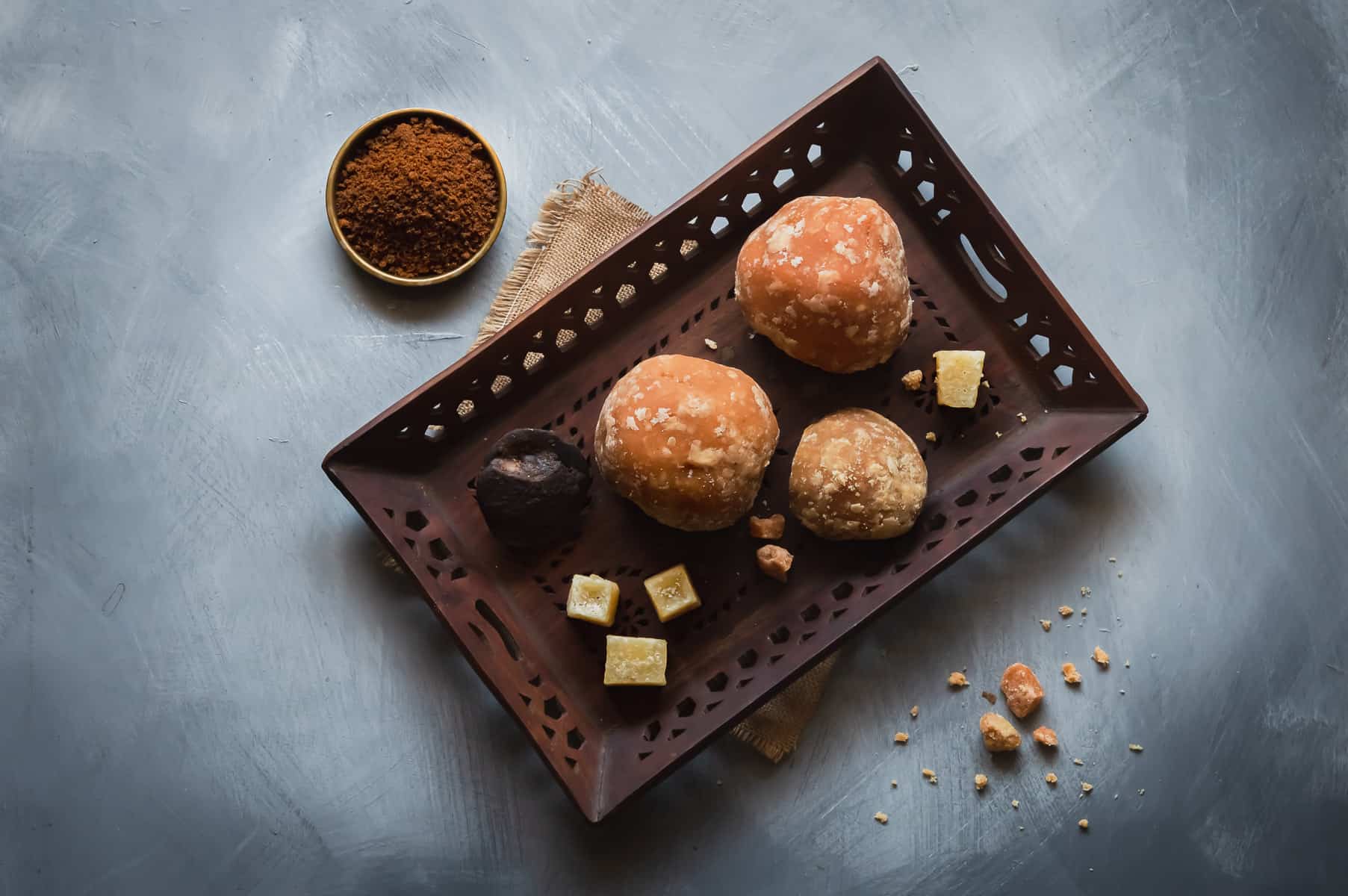
Jump to:
What is Jaggery?
Jaggery is unrefined cane sugar, a natural sweetener existing since ancient times in the Indian subcontinent and surrounding Southeast Asian countries. Latin Americans also consume a similar product named Panela. While Panela is made only from sugarcane juice, gur can be made from the sap of palm, coconut and in rare instances from sago as well.
Native to Papua New Guinea, sugarcane plants travelled all the way to Asia during the late Bronze age. The first mention of sugarcane cultivation in India was recorded in 1500 BC. KT Acharya, in his book: "Indian Food Companion," mentions that sugarcane was referenced in the Atharvaveda scripture: 'I offer you dried sugarcane, white sesamum seeds and bamboos'.
Though sugarcane is native to South America, Indians were the first to process them and discover the world's most common natural sweetener - refined white sugar and other products like jaggery and molasses.
The English word jaggery is derived from the Portuguese word Jagra (Palm Sugar), which is derived from the Sanskrit word śarkarā. (meaning sand or gravel). White sugar is also known as śarkarā due to its grainy texture. The Hindi word Gur or Gud is perhaps derived from Gauda, an ancient name of Bengal - the region was known for its superior varieties of sugarcane.
In India, sugarcane also holds a spiritual and religious significance (of prosperity) during Makar Sankranti or Pongal. It is a nationwide festival that celebrates the end of the harvest season in India. As Indians follow the Lunar calendar, the celebration date varies each year but usually falls around mid-January. The most popular dish made using jaggery is sakkarai pongal, a sweet dish made of rice cooked in milk and sweetened with the traditional sweetener.
Types of Vellam / Jaggery:
Let's discuss the most common varieties of vellam found in India. There are two main vellam varieties. The process of jaggery-making is similar throughout India. Gur, Gud, Guda, Bellam, Vellam, Chakkara are some of the regional names for jaggery.
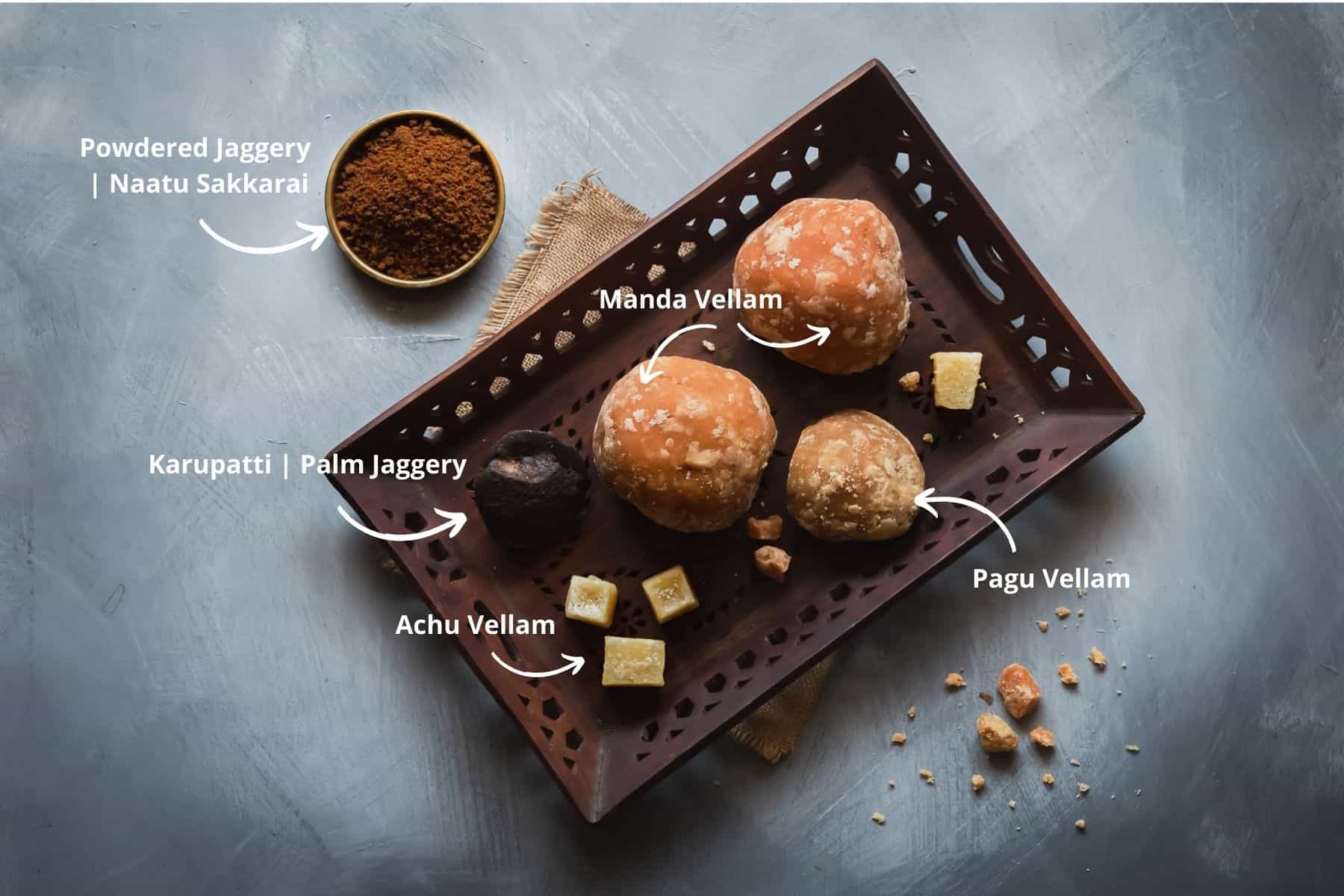
(1) From Sugarcane - Vellam | Gur:
The most common type of jaggery used in Indian cuisine comes from sugarcane sap. Sugarcane juice is boiled, evaporated, and the concentrated (without the separation of molasses) liquid is poured into various moulds and left to sun-dry. From golden yellow to dark brown, it comes in various colours depending on the quality and type of sugarcane used.
*I have only mentioned the Tamil names, as I am familiar with it.
In the South, in Tamil Nadu, based on the shape, jaggery is either called achu vellam (square or cylindrical) or manda vellam (roughly round and larger in size), and the powdered form is known as nattu sakkarai.
Achu Vellam: As soon as the sugarcane syrup concentrates and achieves the desired consistency, it is immediately poured into square-shaped moulds. Once dried and set, they are sold in the market as achu vellam.
Manda Vellam: When you leave the sugarcane concentrate to cool down, it starts to solidify. The solid clumps, while still hot, are roughly rolled into oval sized balls of equal weight. As they resemble the shape of the head, this is known as manda (meaning head in Tamil) vellam. Manda Vellam is also known as urundai (round) vellam or gundu (large) vellam due to its shape.
Pagu Vellam: This is the most sought out type for making traditional sweets in Tamil Nadu. It is usually dark brown in colour, slightly sticky and looks very much alike manda vellam.
In South India, most traditional dishes make use of jaggery syrup and call for one or two string-thread consistencies. Since this pagu vellam melts easily, we prefer to use this for making traditional sweets like adhirasam, vella seedai etc…
Naatu Sakkarai: When the sugarcane concentrate is allowed to cool completely, it hardens more. The hardened mass is crushed and processed further into a powder. Jaggery in powdered form is called Naatu sakkarai in Tamil, which is similar to brown sugar in texture and consistency.
Kakvi: In states like Maharashtra, Goa and Gujarat, the sugarcane concentrate is sold as liquid jaggery, known as Kakvi in the native tongue.
(2) From Date Palm trees - Karupatti | Nolen Gur:
This variety is obtained from the sap of palm / palmyra trees. It is called Karupatti in Tamil and Nolen Gur in Bengal. It is harder than regular jaggery and much darker in colour.
You can substitute karupatti and vellam in any given recipe, though the taste and colour of the final product might slightly vary.
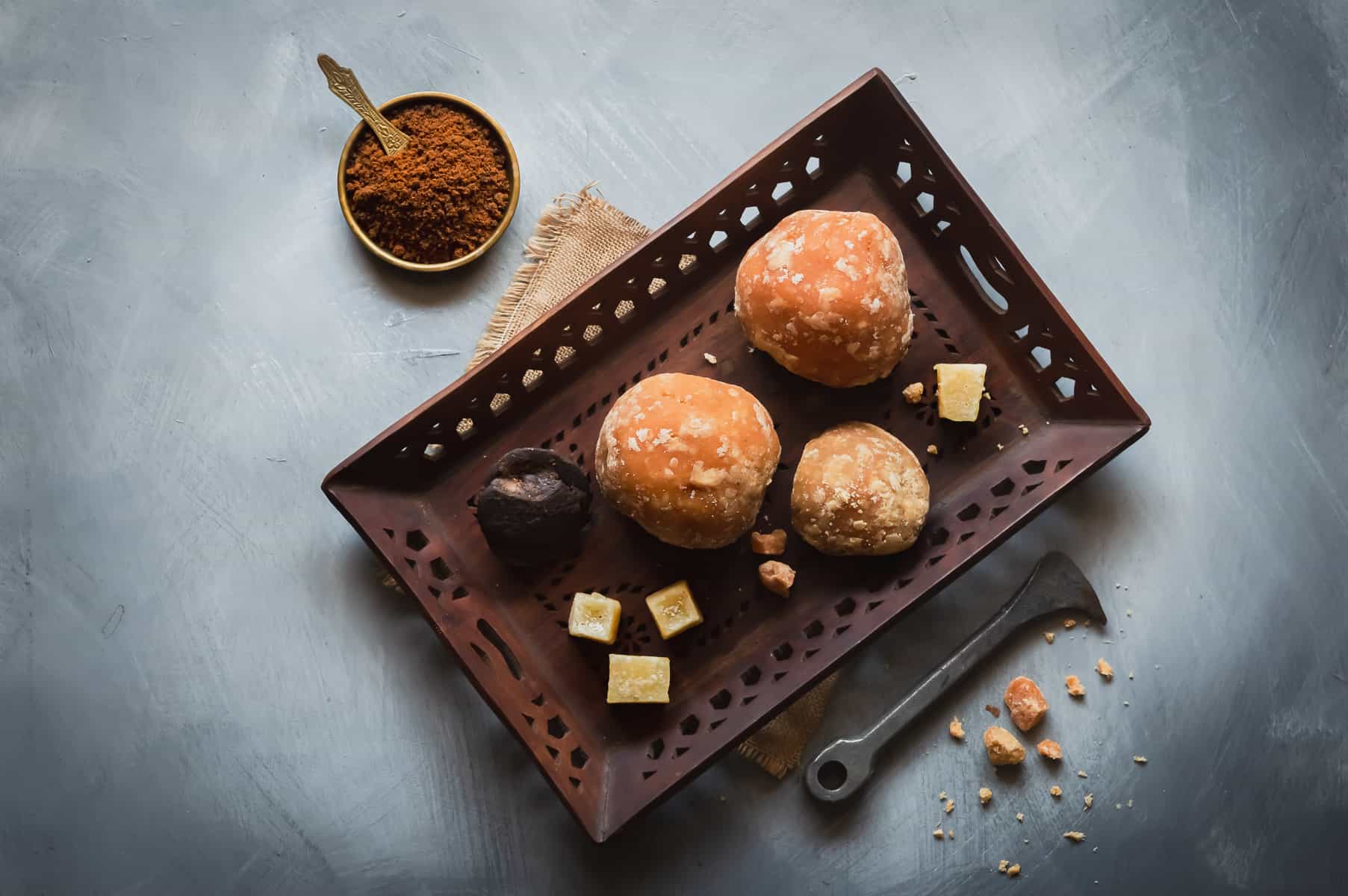
How to use Jaggery in cooking?
As soon as you buy jaggery blocks, break them up into small chunks for ease of use and convenience. If you find it difficult to break them into smaller pieces, refer to this post on "how to break jaggery easily". Once that is done there are many ways in which you can use jaggery in your cooking.
- In the Indian kitchen, jaggery is mainly used as a sweetener to make traditional desserts viz., Athirasam, Vella Seedai, Sakkarai Pongal and Payasam
- Recipes that uses tamarind or any other souring agents recommends to add a pinch of jaggery to balance the sourness. Sambar in Karnataka, Vatha Kuzhambu in Tamil Nadu, Gujarati dals or classic Thai recipes like Pad Thai and sweet chilli sauce are few examples.
- It can also be used to sweeten both hot and cold beverages. You can substitute powdered jaggery for white sugar in your regular tea and coffee. In Tamil Nadu, Sukku kaapi, a hot beverage made of dry ginger and coriander seeds, uses jaggery as a sweetener. Panagam, a summer coolant from Tamil cuisine primarily uses jaggery and dry ginger.
- It can be used in salad dressings, in oatmeals and porridges instead of raw sugar.
- Nowadays, it is also used as a sweetener in baking.
How to buy jaggery?
The colour of the jaggery not only imparts a beautiful golden hue to the finished product, but it is also a key factor in deciding its quality.
Do not buy jaggery that is coloured or looks pale (yellow). As a thumb rule, the darker the colour of the jaggery, the less bleaching agents have been used while processing.
How to store Jaggery and it's Shelf life?
If kept in an airtight container, it lasts for months. Keep it away from heat, moisture and air. If it tastes salty or sour, then it has become rancid. Good quality jaggery is also harder in texture and free of moisture.
Jaggery Recipes from The Magic Saucepan
Now that you are familiar with the type of jaggery, and its uses, do check out the Indian sweets made using this liquid gold.
- Thengai Paal Payasam
- Kadala Parupu Payasam - Jaggery based Payasam
- Sakkarai Pongal | Chakkarai Pongal recipe
- Akkaravadisal | Indian Rice Pudding
- Chenna Poda with jaggery
- Navarathri Arisi Puttu | Rice Flour Puttu
- Thiruvathirai Adai
- Panagam | Panakam - South Indian summer drink
- Sweet mangai pachidi | Raw mango pachidi
- Poorana Kozhukattai | Vella Kozhukattai | Modhakam
Traditional Tamil Festival dishes using jaggery
- Chenna Poda
- Kadalai Paruppu Payasam
- Akkaravadisal
- Navarathri Arisi Puttu
- Sakkarai Pongal
- Thiruvathirai Sweet Adai
- Panagam
- Mangai Pachadi
- Thengai Paal Payasam
- Ellu Poli
- Ellu Thengai Poli
- Vella Seedai
- Thakkali Sweet Pachadi
- Vella Kozhukattai
Benefits of Jaggery:
Gur is one of the ancient staples in Indian kitchens. Indians use jaggery to treat minor ailments such as acidity, constipation and to get instant energy when you feel down. It is full of minerals that provide health benefits. Jaggery is often indulged during winters to beat the cold as it supplies heat to the body. Sweet snacks like gondh ke laddo and til ki ladoo use jaggery as the sweetener.
Though jaggery is a healthier alternative than plain white sugar, it still has glucose and fructose and is advised to conusme in moderation.
References:


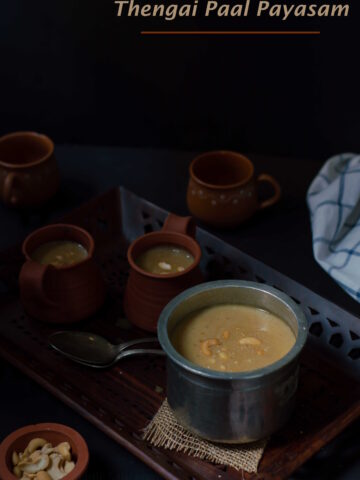







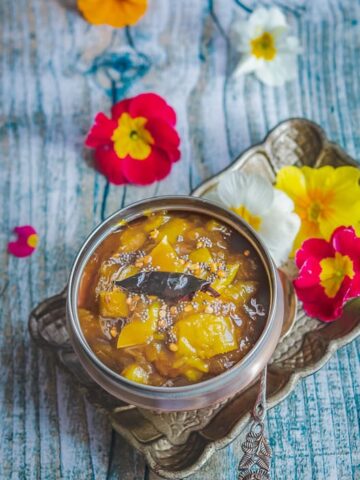





Leave a Reply